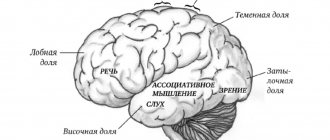Development of perception in preschool children. A person cannot live detached from the world; he feels and understands it with the help of hearing, vision, and tactile sensations. All information enters the brain and is processed efficiently. A preschooler must learn to perceive the world correctly in order to benefit from this for further development.
Features of the development of perception in a child
A preschooler perceives the world through active play, in which he learns and learns something new.
At a young age, preschool children cannot use their imagination; they use the knowledge they receive by using objects. So, if a frog is green, then for a child it can only be green. If an orange is orange, then another fruit of the same color is also an orange for the baby. Three-year-olds do not have a clear perception, they do not know how to analyze.
In the middle groups of kindergarten, pupils already have partial perception. They know colors, they know some geometric shapes, they can compare objects with each other in size and shape, but they do not understand time values. But they can and love to be creative. In many ways, getting to know the world and people for them is about accepting or not accepting appearance and character traits.
Older preschoolers already prefer to see than to hear a hundred times. Auditory perception lags behind visual perception. During this period, the child’s behavior and the qualities of his character are formed, so motivation is important when working with children of this age.
Types of perception
A preschooler gets to know the world based on:
- visual analyzer,
- opportunity to hear
- thanks to touch.
So, with the help of hearing, a child hears speech, music, and various sounds. Sounds surround the child everywhere: at home, on the street, in kindergarten. With the help of vision, the baby evaluates the world around him, including possible danger. He also learns to love the beauty of his native land, works of art, and other beautiful things, without which a person’s life would be dull. A child's tactile abilities allow him to become familiar with the different textures of the materials around him: hot asphalt in summer or cold icicle in winter - everything matters. These tactile sensations are remembered.
Levels of development of perception in a preschooler
Perception in preschoolers has three stages.
The first is subject. Children of primary preschool age can only name objects, but are not able to characterize them.
The second is descriptive. From the age of five, preschoolers can describe what they see, compare it with something, and give an assessment.
The third stage is interpretive. Kindergarten graduates can come up with whole stories, fairy tales, supplement the story with their own feelings, and draw conclusions. He is already using the knowledge he has acquired and trying to apply his experience. This practice will be useful for children in first grade.
Methods for diagnosing the level of development of perception for children 6-7 years old
"Name the objects"
Equipment: 3 drawings in which different, but well-known to children, objects are “hidden”. In total, the pictures show 14 items. Stopwatch. The task is completed within a minute. If the child spent more than a minute, the result is not counted.
Instructions: the child is shown a picture, he must sequentially name all the objects hidden on it. The next picture is presented only if the answer is complete and correct.
Test “Name the objects” for 6-7 years oldEvaluation of results:
| Number of points | Time spent (sec) | Conclusion about the level of development of perception |
| 10 | less than 20 | Very tall |
| 8-9 | 21-30 | High |
| 6-7 | 31-40 | Average* (upper limit of normal) |
| 4-5 | 41-50 | Average (lower limit) |
| 2-3 | 51-60 | Short |
*The average level corresponds to the age norm.
“What did the artist forget to draw?”
Equipment: 7 drawings (pictures) of objects, each missing one essential detail. Stopwatch.
Test “What the artist forgot” for children 6-7 years old
Instructions: Look carefully. Each picture is missing an important detail. Name her. The result is counted if the missing details in all the pictures are named.
| Number of points | Time spent (sec) | Conclusion about the level of development of perception |
| 10 | less than 25 | Very tall |
| 8-9 | 26-30 | High |
| 6-7 | 31-35 | Average (upper limit of normal) |
| 4-5 | 36-40 | Average (lower limit) |
| 2-3 | 41-45 | Short |
| 0-1 | 45 or more | Very low |
https://youtube.com/watch?v=NH13hKE_ueQ
I like it I don't like it
Exercises and games to develop perception in preschoolers
To develop perception in preschoolers, the child’s age must be taken into account. After all, what is understandable to a five-year-old will be very complex and inexplicable for three-year-olds. In particular, musical games with noise effects of natural sounds are suitable for children of middle and older groups, but not younger ones. It will also be difficult for young children to play with the shades of colors. But they will be interested in finding objects of the desired shape and specific color, and beating the rhythm. Older preschoolers can be offered complex game programs for the development of different perceptions.
Development of auditory perception
There are many sounds in the world, and each object and phenomenon has its own characteristic sound. The child must learn to understand these sounds. How the rain makes noise, how the leaves rustle, how the locomotive hums, how the birds chirp - all this is important. Toddlers do not perceive natural sounds well, but older preschoolers are already able to hear characteristic features if time is devoted to the development of auditory perception. Why is it important to learn to hear? Because without this it is impossible to speak correctly and clearly.
With kids you need to play games that develop a sense of rhythm. Sentencing handclaps are a great idea. With older children, you can already explore the sounds of nature. Walks, excursions through the forest, and the street are suitable for this.
Auditory perception is impossible without auditory attention. Therefore, you need to play “Deaf Telephone” with preschoolers, where you need to activate your hearing.
Another interesting game that children will enjoy is “Radio Theatre”. A preschooler hears a fairy tale that is read role-playing. And the child must find out which character owns the voice, intonation, and phrase.
How to develop auditory perception in children: VIDEO
Development of visual perception
At primary preschool age, children already know the names of primary colors. For them, color perception lives in four colors: red, yellow, blue and green. All other shades are unimportant. In addition, the main assessment is “beautiful” and “ugly,” and the child’s subjective opinion plays a role here.
Later, the child, recognizing new colors and learning to understand them and their shades, begins to more realistically evaluate what he sees. To develop visual perception, you can also suggest drawing a picture using dots. An interesting game will be in which the player is asked to walk through a “labyrinth”. The labyrinth is the path shown in the picture.
There may be a character on one side of the maze, and a character's goal on the other. For example, a child is asked to help a bear cub get to a barrel of honey. So, on one side of the maze there is a bear cub, on the other there is a barrel. The child must lead his finger along the drawn path, looking for the right path. It will also be useful to invite children to find the shadows of any character depicted in the picture. Attentiveness and the ability to notice little things are what this game develops.
Games to develop visual perception: VIDEO
Development of visual perception and attention in children with disabilities: VIDEO
Development of phonemic awareness
Development of perception in preschool children. Phonemic awareness includes:
- the ability to hear and identify sounds in words,
- the ability to determine where exactly a particular sound is located in a word,
- the ability to distinguish words that are similar in sound but different in meaning.
If a child knows how to do this, he will be able to learn to speak correctly, which means he will not have problems at school.
Games where children learn to recognize objects by sounds are well suited for the development of phonemic awareness. For example, a whistle whistles, cereal rustles, water makes noise, a car hums. It is also important to teach your child to hear soft and loud sounds and recognize them correctly. Another feature of phonemic perception is the understanding of the distance or proximity of sounds.
To develop phonemic awareness, the teacher often uses audio recordings with sounds of nature, and then invites children to answer what exactly they heard, offering pictures that depict various natural phenomena.
A good game would be to invite preschoolers to find out what is in the box. The box is shaken, and by the sound the children try to find out what is hidden.
To help children learn to identify the source of a sound, you can play “Bell.” In this case, the presenter places a blindfolded player in the center of the hall, and hands one of the children a bell. The child is calling. The player wearing the blindfold must indicate the direction from which the sound is coming.
Techniques for the development of phonemic hearing: sound-letter analysis in children with ODD: VIDEO
Games for developing phonemic awareness: VIDEO
Development of musical perception
Development of perception in preschool children. If very young children distinguish music by contrast, then by the age of three they already remember individual melodies they like. By the age of five, children not only sing songs, but also understand the musical mood and can distinguish the tempo of music, dynamics, duration of sounds, and rhythm. Older preschoolers are able to distinguish musical works by emotional coloring and know the terms. Children can even tell you how they feel when they hear a particular tune.
Many teachers believe that in preschool age it is useful for children to listen to classical works: N. A. Rimsky-Korsakov, P. I. Tchaikovsky, D. D. Shostakovich and others. It is also useful to introduce children to folklore. Folk dances and songs are a good opportunity not only to introduce preschoolers to folk art, but also to develop children’s musical perception.
The third step is to teach the children songs written specifically for this age. These can also be songs from children's films and cartoons. Moreover, all songs must be in genres known to children.
Development of tactile perception
Types of perception of preschoolers
Olga Skipina
Types of perception of preschoolers
We all ask the question: “How does the child perceive the environment around him?”
.
Some perceive it by ear , others need to see it. Why? It turns out that everything is simple, there are various types of perception of preschoolers : visual, auditory, kinesthetic, discrete. How they perceive the world , why, why, we will try to figure it out and help these children develop in our world.
And so the visuals (“eye-watchers”)
– such a child lives in a colorful world and vivid images. He likes to look at books, magazines, and advertising brochures. He pays attention not only to his clothes, but also to other people; he will definitely notice if mom dyes her hair a different color, and dad puts on a new tie or decides to buy a mobile video recorder for the car. For such a child, television is an object of “worship”; he can watch all the programs in a row. But it will be difficult for him to tell what the fairy tale his mother just read was about.
Audials (“eared ears”)
– children with this type of
perception are usually talkative, enjoy listening to their mother’s fairy tales, audio books, children’s songs, and quickly memorize poems and fairy tales. In the presence of such a child, you should carefully monitor your speech and not “sin” with obscene epithets, because he is prone to onomatopoeia, and “bad” words may appear in his vocabulary. with visual perception - he will bring a ball of the wrong color that he was asked for, and does not remember drawn graphic symbols and images.
Kinesthetic (“motor”)
– such a baby keeps his parents in constant tension, because he prefers to be “active”, for which he usually hears the following words addressed to him: “spindle”, “fidget”, “fidget”. “Motor” is difficult to sit down with a book, and his toys “live” for a short time. Sitting quietly is a real challenge for such a baby. If his dad decides to buy a recorder and leaves the baby alone with the device for at least half a minute, the device will be disassembled into small parts, along with his mother’s cell phone and his brother’s player. You have to watch these children very carefully.
As a rule, types of perception do not occur : kinesthetic is combined with either visual or auditory. In order for the baby to grow up as a harmonious and comprehensive personality, to receive and process, if necessary, any kind of information, it is necessary to develop the type of perception that the child is given with less desire, that is, for an auditory learner to develop visual perception , for example, in the form of a game: tell write a poem to him and ask him: “What color is the dolphin?”, “What is the hedgehog carrying on its back?”
Choosing a gift for a child is quite difficult, since you want the thing to bring joy, happiness and delight to him. But this doesn’t always work out. One of the main reasons for this is ignorance of the child’s perception . There are four of them, and each of them needs to choose appropriate gifts.
The first type is kinesthetic. These kids should try everything by touch, because for them the most important thing is touch. Kinesthetic learners rarely like to listen to fairy tales before bed, however, if you take him in your arms or stroke him, he will probably listen to the end. Don’t be surprised that children of this type have all their toys disassembled or broken - this is natural for them. The best gifts for such a person would be soft toys, pillows, construction sets, homemade games, as well as anything that can be touched, pulled, squeezed and bent.
Discrete children are children who often keep their distance from everyone. As a rule, these are those who lack attention: children without one parent or even orphans. However, it also happens that a child in a full-fledged family has a discrete type of perception . This is a clear sign that your child needs to spend more time. And all the gifts that you give him should show how much you love your child. The most important condition is to give games and toys that the whole family can play with. Educational board games, chess and badminton are exactly what you need. If your child is a visual person, then most likely he does not like touching and hugging at all. The main thing for him is to observe. As a rule, visual people look older than their age and try to look like adults. Kids with this type of perception remember every little thing they see, and they also have excellent taste. Therefore, the best gifts for visual learners will be stylish designer gifts - paintings, illustrated books, lamps, as well as any educational videos. Unlike visual learners, auditory learners perceive most information by ear . These children remember everything that adults say, although they do not try to remember it. Even if you talk in a whisper in another room, most likely the baby will hear, because he has excellent hearing. Children of this type are inclined to music, so from an early age give them musical instruments - first xylophones and simple keyboards, and then a real guitar or violin.
But do not forget that pure types of perception are quite rare; most likely, the baby partially has two or three of them. But, if you are attentive to your child, you will definitely see what types of perception the child is endowed with .
Methods for developing different types of perception
Here are several methods for developing perception of different types.
Size, color and shape
In this case, children are asked to take out objects of only one color from the boxes. Or suggest taking out only square objects, or only round ones. You can prepare boxes painted in different colors, and in them the child must put objects of the color in which the box is painted.
What's lost?
In this game, not only vision and attentiveness work, but also thinking. The child is asked to look at a picture showing different objects. But they are not finished yet. For example, a bicycle is missing a wheel, and a house has no windows. The child must tell what is missing.
Smell and guess
Smell works in this game. The child is blindfolded, in front of him are vegetables and fruits, and other products that the player must name, guided by smell.
Magic sound
A game that awakens the imagination and ears. Child with closed eyes. The presenter plays sounds, including the audio system: the sound of rain, the sound of a steam locomotive, the chirping of birds, etc. The child names who the sounds belong to.
Tactile riddle
There are objects in the container. The child, without looking, must determine by touch what it is. Objects must be of different sizes, shapes, smooth or rough.
Types and characteristics of perception in children
Our brain interprets the surrounding reality and receives useful information from it. Each of us has an optimal way of receiving information. Understanding how our child perceives information will help us develop his learning abilities. Research shows that 20-30% of people remember information through hearing, 40% through vision, and the rest remember best when they write down what they hear or apply the acquired knowledge in practice.
Types of perception
There are three types of perception - visual, auditory and kinesthetic (tactile). Organized children who love to read and notice details are visual types. Children who have well-developed speech skills, a penchant for learning foreign languages and musical talents belong to the auditory type. Children who like to act out and be physically active, use body language to explain things, and like to write are kinesthetic types. By observing a child, you can determine his type of perception - this will help parents and teachers maximize the use of different parts of the child’s brain in the process of his learning.
Children with visual perception
Children with a visual type of perception like to see the big picture of what is happening. They need the information to be presented in an attractive manner. They have well-developed visualization skills. These children should be exposed to fun activities that engage their speaking and reading skills. Link these activities to your child's learning by developing their vocabulary and pronunciation to improve their performance in school.
- Give your child a list of nouns, verbs, adjectives and pronouns that you will use in class. If at school your child is given a task to learn any words, add them to the list. Let your child choose colors for each group of words. Write the words on different colored cards.
- Invite your child to sort the cards by color.
- Invite your child to make sentences or coherent text from the words. This will teach a visual child to see the big picture and the end goal of the lesson.
- When your child can make sentences out of words, encourage him to make a story using all the words.
- Involve kinesthetic and auditory perception in the learning process: invite him to read the story out loud and act out a skit based on it.
Children with auditory perception
Auditory children perceive information better when something is explained to them in detail. According to research, auditory learners often talk to themselves, like to explain things to others, and have difficulty remaining silent for long periods of time.
Use their desire to talk when teaching auditory children. Offer them activities that involve speaking and listening skills.
- Talk to your child about his favorite food. Let him tell you all the reasons why he likes a particular dish. Ask what it tastes like and how the child feels about it.
- Help your child find a recipe for this dish on the Internet or in a cookbook. Make a copy of the recipe for your class.
- Encourage your child to read the recipe aloud to develop their auditory comprehension.
- As your child reads the recipe, encourage him to circle the words he liked from the text with a colored marker.
- Encourage your child to measure out the required amount of ingredients to prepare the dish. Describe the entire process out loud.
- Before trying the food, give your child a pen and paper and encourage him to describe his cooking experience. Thus, his auditory perception will be combined with kinesthetic perception. If a child illustrates his text, the visual channel of perception will also be involved.
- Invite your child to serve the prepared dish to all family members. At the same time, he must tell how the dish was prepared and whether he liked cooking it.
Children with kinesthetic perception
Kinesthetic children cannot sit still and constantly play outdoor games. Children with kinesthetic perception are considered difficult students because they are too active. But in fact, for successful learning, you need to include movement in this process.
Use games to teach a kinaesthetic child. Combine gameplay with learning modules (which may include new words or historical dates). During the game, the child will better remember the material and also enjoy the game itself.
- Choose the names your child needs to learn and have him write them down on cards. It’s especially good to learn new words this way.
- When your child writes down the words, invite him to read them out loud and write them with his finger in the air or on the surface of the table - this way the brain remembers the information better. On the back of the cards write tasks: “show”, “draw” or “explain”.
- After this, give your child a short break so that he can better concentrate on the game.
- Prepare everything you need for the game: notebooks, pencils, markers, etc.
- Invite your child's friends or family members to play. Shuffle the cards and invite your child to draw one of them. He must show, draw or explain the word written on the card without saying it. The rest must guess what word is written on the card.
- Allow players to change until all the words have been guessed. If your child cannot sit still while someone else is playing, find a place in the room where he can move around without disturbing others.
Understanding your child's perceptual characteristics gives you additional opportunities to find the optimal way for him to learn without exposing him to frustration. Use activities that work best for your child. This will help him learn better and strengthen your bond with him.
Related links:
- If your child is a visual learner, what does that mean?
- How to develop a child's phonemic awareness
- Developing children's spatial perception
- How to make your child's learning effective
- More articles on the psychology of children and adolescents
Perception disorders and causes
Development of perception in preschool children. Perception disorders are the inability to correctly perceive surrounding sounds and objects. Such a person is disoriented; he cannot really assess the reality around him.
The causes of perception impairment may be:
- pathology of the central nervous system, including due to diseases;
- mental disorders;
- reaction to taking complex medications such as antidepressants, antivirals and others;
- drug addiction, including congenital;
- trauma resulting in damage to the nervous system;
- physical and mental fatigue of the body;
- visual defect.
A child suffering from perception disorders needs to work with specialists who will create an individual program. But at the same time, the family can help solve the problem in the following ways:
Follow a daily routine
Get up and go to bed at the same time, eliminate those actions that cause fear and emotional stress.
Light
The child does not perceive the shape and color of objects well, and in poor lighting it becomes even worse. Therefore, the light should be bright, but soft.
Colors
So that the nervous system does not experience additional stress, it is necessary that the child’s room has as little gloss and ornaments as possible and as many solid colors as possible.
Daily activities to develop perception
Games to develop the ability to understand the size, size and shape of an object, as well as its color, and to develop sound and visual perceptions should be built taking into account the characteristics of children with disabilities. For example, you can offer to play such a game. It is proposed to insert an element of the same shape into specific puzzles. Of course, the child will not succeed right away, but over time he will experience small success. You can also use games that require tactile sensations. Playing with sand is also calming and develops fine motor skills.
Methodology for the development of perception
According to famous psychologist Dale Carnegie, sympathy can be aroused with a simple smile.
Therefore, it is worth paying attention to your smile and learning to smile at passers-by and, in the future, at your interlocutors, in order to start a dialogue, and then create a strong and lasting communication connection
A sincere smile evokes sympathy by default
Today there are many cunning techniques and psychological tricks in dialogue that will allow you to understand your interlocutor and enhance the transmission of your emotions.
You can also gesticulate more and develop facial expressions to make the conversation more lively and make it easier for the interlocutor to convey information.
This will improve the quality of social perception and understand people.
The practice of American psychologist, professor and specialist in the field of psychology of emotions and lie detection Paul Ekman is one of the most effective ways to obtain and develop social perception skills.
It is based on focusing attention in three areas of a person’s face: forehead, chin and nose. Paul Ekman believes that it is the nose, chin and forehead that reflect various emotional states of a person, for example, anger, fear, disgust, sadness.
By analyzing a person’s facial expressions and gestures during a dialogue, you can understand what mood the interlocutor is in and what he is feeling at the moment. The skill of recognizing emotions and gestures allows you to strengthen contact between people. This way you can know what is best to say during the dialogue.
What influences the development of perception in a child
Development of perception in preschool children. At preschool age, a child’s mental development is formed, and thinking begins to actively work. If any perception is “asleep,” it will be more difficult for the child to explore the world and acquire new knowledge, which means it will be more difficult for him later in school.
The development of a child’s perception is greatly influenced by his environment and the adults who are next to him. Educational games, which are used by teachers to develop perception, should not only simply reproduce some details from a child’s life, but also be informative, teach him, force him to learn more. It is the desire to know and try that becomes a kind of motor that moves the child in his development.
Types of perception in preschoolers based on perceptual systems
The main types of perception in preschoolers are based on various analyzers:
- Visual, allowing you to visually evaluate all the properties of an object;
- Hearing, which helps to learn speech, recognize the native language, feel the sounds of nature, hear music;
- Tactile, providing knowledge of an object through touch.
Auditory
With the help of hearing, the child learns to recognize the sounds of his native language, words and syllables. If in infancy the perception of speech is based on the rhythmic and melodic structure of words and sentences, then already at 1 year the formation of phonemic hearing begins. The baby needs another year for the acceptance of all the sounds of his native language to take shape and for the formation of a sound culture of speech to begin.
The development of auditory perception is most effective during walks, when the baby listens to the noise of the street, birdsong, the sound of rain, and steps. An excellent exercise is to close your eyes and try to understand from which side the bird is singing, or whether a car is driving far or close.
Visual
Visual perception is the leading one in preschool age. The ability to read, see the beauty of the world, and assess danger depends on it
Its leading role is justified by the fact that vision allows you to capture the entire object as a whole, as well as see details
Visual signals arrive before the preschooler touches or tastes an object. In addition, examining an object is much safer than other methods of research.
Only at an early age, when the baby begins to comprehend the surrounding reality, his “eyes” are his hands. But at this stage, parents make sure that the child is in a protected space and that only safe objects are in his hands.
According to statistics, the number of visual people (who prefer visual perception) prevails in the world, so the development of this type requires special attention. The task of an adult in preschool age is to sharpen the child’s visual perception, and also to help him expand the range of perceived details.
With preschoolers you need to draw more, study pictures and illustrations. It is these children who enthusiastically engage in appliqué, putting together puzzles and mosaics, continuing to develop their visual senses.
Tactile
Tactile or kinesthetic perception is directly related to touch. Younger preschoolers still trust their hands even more when familiarizing themselves with a new subject. That’s why they so insistently ask to give them something that interests them. More details about tactile perception.
Playing with materials of different structures, modeling, natural substances is a great way to develop the sense of touch. With their eyes closed, children enjoy rolling the foil into balls and smoothing it out. Great joy comes from the exercise of identifying bulk material in a cup. The eyes, of course, must also be blindfolded.









